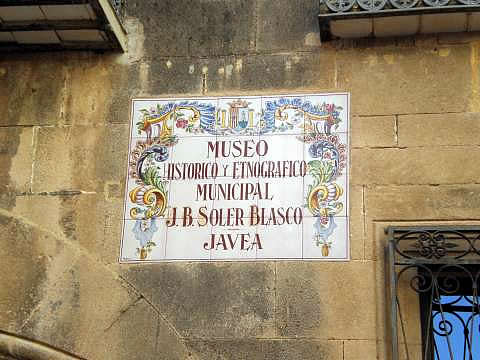AMUX pays a visit to the Punta de Moraira: Torre de Cap d'Or and excavation of Iberian/Roman remains20/9/2020
On Thursday 17th September, eight members and friends of AMUX had an exclusive guided tour of recent excavations of the Iberian settlement and the Torre de Cap d’Or on the Punta de Moraira. Our guide was archaeologist, Rubén Vidal Bertomeu, leader of the study. The excavation is part of a programme by the Teulada Town Hall to improve the site as a cultural and tourism resource. As such, they are improving the access path and creating viewing platforms along the way as well as improving access to the Cova de Cendres which is an important prehistoric site.
The excavated area is but a small portion of the whole settlement which covers about 5000m2 of the top of the cape. Its location has wonderful views over the harbour of Moraira and Penyon de Ifach to the south, as well as the steep cliffs to the north. This made it an ideal place for maritime control through the ages.
The Torre de Cap d’Or is presently covered in scaffolding and undergoing renovation. Rubén explained that this watch tower, which dominates the cape, was badly renovated in 1991, and they are now working to restore it to how it would have looked when it was built at the end of the 16th Century. Interestingly there was another tower there before, built in the mid 16th Century, but this was demolished by the very pirates it was trying to defend against. A hole excavated in the bottom of the current tower has revealed the wall of the original tower nested inside like a Russian doll.
The excavated part of Iberian site surrounding the tower may date back to 400-500 BCE but the whole area has been very much disturbed by agriculture and the building of terraces. One of the structures found was a relatively modern stone building with a chimney. However, the remains of older structures can be seen and include Roman remains from the times of the Punic wars (264-146 BCE) and Sertorian civil war (75 BCE). Rubén pointed out Roman walls constructed on the top of pre-existing Iberian ones; an area which could have been a living area in Iberian times, with evidence of an earth floor and hearth, as well
as a well preserved water cistern (aljibe) from that time. All the excavated structures will be preserved for visitors to see. The group from AMUX were then shown more defensive walls which had come to light outside the excavation area. These overlook the Portet beach towards the south. We also saw a vaulted 16th Century water cistern. There is much more still hidden, waiting for future archaeological campaigns.
0 Comments
Date and time: Thursday, September 17th at 18.00 (6 p.m).
Meeting point: The Beginning of the footpath at the end of Calle Puerto de Alcúdia (see map below).This is in the urbanisation on the slopes above the Portet de Moraira Beach. Parking is available in the roads nearby. The footpath (SL-CV51), is short (approximately 1 km), but steep, slippery and rocky in some places (93m ascent). Members will need to be in good physical shape, wear hiking boots and bring water. The walk to the Iberian site and the tower will take about 30 minutes, and we should be back to the road by 8pm. Our guide will be Rubén Vidal Bertomeu, archaeologist and director of excavations. |
ACTIVITIES
Categories |
- Home
- Blogs
-
Projectes
- Premio de Investigación - Formularios de Inscripción
-
Traducciones Translations
>
-
DISPLAY PANELS - GROUND FLOOR
>
- THE STONE AGES - PALAEOLITHIC, EPIPALAEOLITHIC AND NEOLITHIC
- CAVE PAINTINGS (ARTE RUPESTRE)
- CHALCOLITHIC (Copper) & BRONZE AGES
- THE IBERIAN CULTURE (THE IRON AGE)
- THE IBERIAN TREASURE OF XÀBIA
- THE ROMAN SETTLEMENTS OF XÀBIA
- THE ROMAN SITE AT PUNTA DE L'ARENAL
- THE MUNTANYAR NECROPOLIS
- ARCHITECTURAL DECORATIONS OF THE PUNTA DE L'ARENAL
- THE ATZÚBIA SITE
- THE MINYANA SMITHY
- Translations archive
- Quaderns: Versión castellana >
- Quaderns: English versions >
-
DISPLAY PANELS - GROUND FLOOR
>
- Catálogo de castillos regionales >
- Exposició - Castells Andalusins >
- Exposición - Castillos Andalusíes >
- Exhibition - Islamic castles >
- Sylvia A. Schofield - Libros donados
- Mejorar la entrada/improve the entrance >
-
Historia y enlaces
-
Historía de Xàbia
>
- Els papers de l'arxiu, Xàbia / los papeles del archivo
- La Cova del Barranc del Migdia
- El Vell Cementeri de Xàbia
- El Torpedinament del Vapor Germanine
- El Saladar i les Salines
- La Telegrafía y la Casa de Cable
- Pescadores de Xàbia
- La Caseta de Biot
- Castell de la Granadella
- La Guerra Civil / the Spanish civil war >
- History of Xàbia (English articles) >
- Charlas y excursiones / talks and excursions >
- Investigacions del museu - Museum investigations
- Enllaços
- Enlaces
- Links
-
Historía de Xàbia
>
- Social media
- Visitas virtuales
- Tenda Tienda Shop


 RSS Feed
RSS Feed
